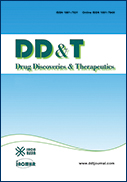Volume 11, Issue 1
Displaying 1-10 of 10 articles from this issue
- |<
- <
- 1
- >
- >|
Reviews
-
2017 Volume 11 Issue 1 Pages 1-5
Published: February 28, 2017
Released on J-STAGE: March 22, 2017
Advance online publication: February 21, 2017Download PDF (591K) -
2017 Volume 11 Issue 1 Pages 6-14
Published: February 28, 2017
Released on J-STAGE: March 22, 2017
Advance online publication: January 26, 2017Download PDF (3039K) -
2017 Volume 11 Issue 1 Pages 15-19
Published: February 28, 2017
Released on J-STAGE: March 22, 2017
Advance online publication: February 14, 2017Download PDF (351K) -
2017 Volume 11 Issue 1 Pages 20-24
Published: February 28, 2017
Released on J-STAGE: March 22, 2017
Advance online publication: February 13, 2017Download PDF (257K)
Original Articles
-
2017 Volume 11 Issue 1 Pages 25-29
Published: February 28, 2017
Released on J-STAGE: March 22, 2017
Advance online publication: February 14, 2017Download PDF (1171K) -
2017 Volume 11 Issue 1 Pages 30-34
Published: February 28, 2017
Released on J-STAGE: March 22, 2017
Advance online publication: February 14, 2017Download PDF (275K) -
2017 Volume 11 Issue 1 Pages 35-40
Published: February 28, 2017
Released on J-STAGE: March 22, 2017
Advance online publication: February 08, 2017Download PDF (468K) -
2017 Volume 11 Issue 1 Pages 41-46
Published: February 28, 2017
Released on J-STAGE: March 22, 2017
Advance online publication: January 26, 2017Download PDF (1431K)
Case Report
-
2017 Volume 11 Issue 1 Pages 47-50
Published: February 28, 2017
Released on J-STAGE: March 22, 2017
Advance online publication: January 26, 2017Download PDF (627K) -
2017 Volume 11 Issue 1 Pages 51-53
Published: February 28, 2017
Released on J-STAGE: March 22, 2017
Advance online publication: February 13, 2017Download PDF (313K)
- |<
- <
- 1
- >
- >|
